SCM Practices Impact on Competitive Advantage in Textile Sector
VerifiedAdded on 2021/06/02
|23
|7599
|75
Project
AI Summary
This project delves into the impact of supply chain management (SCM) practices on competitive advantage, specifically within the textile sector of Karachi. The research investigates the effects of customer relationship management, information sharing, and strategic supplier partnerships. The introduction provides background on the globalized and competitive market landscape, emphasizing the importance of efficient SCM for organizational survival and profitability. The problem statement highlights the challenges firms face in identifying effective SCM practices to gain a competitive edge. Research objectives include studying the impact of customer relationship management, information sharing, and strategic supplier partnerships on competitive advantage. The literature review explores the concept of competitive advantage and details SCM practices. The methodology chapter will outline the research design, sampling, and data collection methods. The study aims to provide guidance to organizations on achieving competitive advantage through SCM practices, particularly in the textile sector, and to identify which practices contribute most to this advantage.
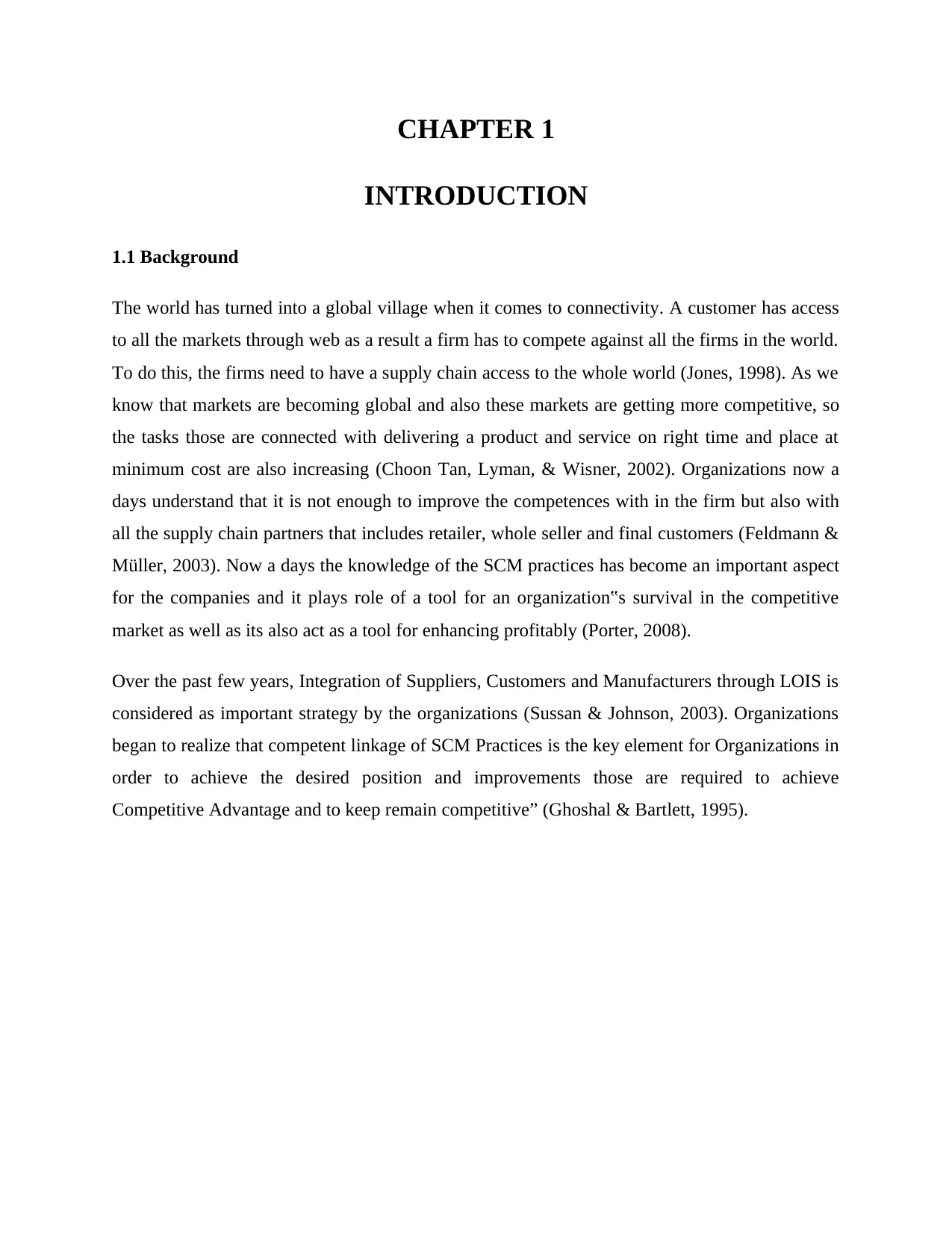
CHAPTER 1
INTRODUCTION
1.1 Background
The world has turned into a global village when it comes to connectivity. A customer has access
to all the markets through web as a result a firm has to compete against all the firms in the world.
To do this, the firms need to have a supply chain access to the whole world (Jones, 1998). As we
know that markets are becoming global and also these markets are getting more competitive, so
the tasks those are connected with delivering a product and service on right time and place at
minimum cost are also increasing (Choon Tan, Lyman, & Wisner, 2002). Organizations now a
days understand that it is not enough to improve the competences with in the firm but also with
all the supply chain partners that includes retailer, whole seller and final customers (Feldmann &
Müller, 2003). Now a days the knowledge of the SCM practices has become an important aspect
for the companies and it plays role of a tool for an organization‟s survival in the competitive
market as well as its also act as a tool for enhancing profitably (Porter, 2008).
Over the past few years, Integration of Suppliers, Customers and Manufacturers through LOIS is
considered as important strategy by the organizations (Sussan & Johnson, 2003). Organizations
began to realize that competent linkage of SCM Practices is the key element for Organizations in
order to achieve the desired position and improvements those are required to achieve
Competitive Advantage and to keep remain competitive” (Ghoshal & Bartlett, 1995).
INTRODUCTION
1.1 Background
The world has turned into a global village when it comes to connectivity. A customer has access
to all the markets through web as a result a firm has to compete against all the firms in the world.
To do this, the firms need to have a supply chain access to the whole world (Jones, 1998). As we
know that markets are becoming global and also these markets are getting more competitive, so
the tasks those are connected with delivering a product and service on right time and place at
minimum cost are also increasing (Choon Tan, Lyman, & Wisner, 2002). Organizations now a
days understand that it is not enough to improve the competences with in the firm but also with
all the supply chain partners that includes retailer, whole seller and final customers (Feldmann &
Müller, 2003). Now a days the knowledge of the SCM practices has become an important aspect
for the companies and it plays role of a tool for an organization‟s survival in the competitive
market as well as its also act as a tool for enhancing profitably (Porter, 2008).
Over the past few years, Integration of Suppliers, Customers and Manufacturers through LOIS is
considered as important strategy by the organizations (Sussan & Johnson, 2003). Organizations
began to realize that competent linkage of SCM Practices is the key element for Organizations in
order to achieve the desired position and improvements those are required to achieve
Competitive Advantage and to keep remain competitive” (Ghoshal & Bartlett, 1995).
Paraphrase This Document
Need a fresh take? Get an instant paraphrase of this document with our AI Paraphraser
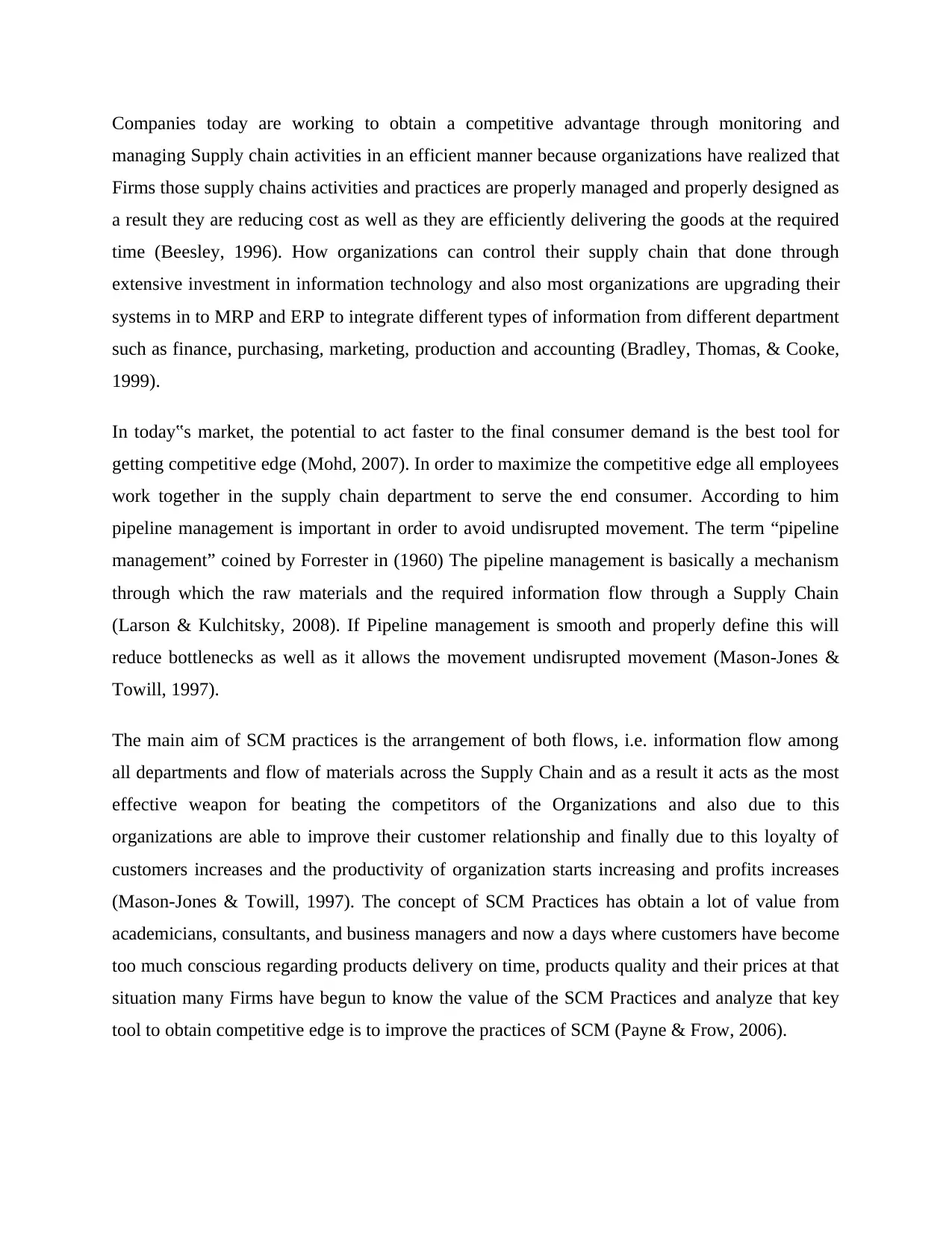
Companies today are working to obtain a competitive advantage through monitoring and
managing Supply chain activities in an efficient manner because organizations have realized that
Firms those supply chains activities and practices are properly managed and properly designed as
a result they are reducing cost as well as they are efficiently delivering the goods at the required
time (Beesley, 1996). How organizations can control their supply chain that done through
extensive investment in information technology and also most organizations are upgrading their
systems in to MRP and ERP to integrate different types of information from different department
such as finance, purchasing, marketing, production and accounting (Bradley, Thomas, & Cooke,
1999).
In today‟s market, the potential to act faster to the final consumer demand is the best tool for
getting competitive edge (Mohd, 2007). In order to maximize the competitive edge all employees
work together in the supply chain department to serve the end consumer. According to him
pipeline management is important in order to avoid undisrupted movement. The term “pipeline
management” coined by Forrester in (1960) The pipeline management is basically a mechanism
through which the raw materials and the required information flow through a Supply Chain
(Larson & Kulchitsky, 2008). If Pipeline management is smooth and properly define this will
reduce bottlenecks as well as it allows the movement undisrupted movement (Mason‐Jones &
Towill, 1997).
The main aim of SCM practices is the arrangement of both flows, i.e. information flow among
all departments and flow of materials across the Supply Chain and as a result it acts as the most
effective weapon for beating the competitors of the Organizations and also due to this
organizations are able to improve their customer relationship and finally due to this loyalty of
customers increases and the productivity of organization starts increasing and profits increases
(Mason-Jones & Towill, 1997). The concept of SCM Practices has obtain a lot of value from
academicians, consultants, and business managers and now a days where customers have become
too much conscious regarding products delivery on time, products quality and their prices at that
situation many Firms have begun to know the value of the SCM Practices and analyze that key
tool to obtain competitive edge is to improve the practices of SCM (Payne & Frow, 2006).
managing Supply chain activities in an efficient manner because organizations have realized that
Firms those supply chains activities and practices are properly managed and properly designed as
a result they are reducing cost as well as they are efficiently delivering the goods at the required
time (Beesley, 1996). How organizations can control their supply chain that done through
extensive investment in information technology and also most organizations are upgrading their
systems in to MRP and ERP to integrate different types of information from different department
such as finance, purchasing, marketing, production and accounting (Bradley, Thomas, & Cooke,
1999).
In today‟s market, the potential to act faster to the final consumer demand is the best tool for
getting competitive edge (Mohd, 2007). In order to maximize the competitive edge all employees
work together in the supply chain department to serve the end consumer. According to him
pipeline management is important in order to avoid undisrupted movement. The term “pipeline
management” coined by Forrester in (1960) The pipeline management is basically a mechanism
through which the raw materials and the required information flow through a Supply Chain
(Larson & Kulchitsky, 2008). If Pipeline management is smooth and properly define this will
reduce bottlenecks as well as it allows the movement undisrupted movement (Mason‐Jones &
Towill, 1997).
The main aim of SCM practices is the arrangement of both flows, i.e. information flow among
all departments and flow of materials across the Supply Chain and as a result it acts as the most
effective weapon for beating the competitors of the Organizations and also due to this
organizations are able to improve their customer relationship and finally due to this loyalty of
customers increases and the productivity of organization starts increasing and profits increases
(Mason-Jones & Towill, 1997). The concept of SCM Practices has obtain a lot of value from
academicians, consultants, and business managers and now a days where customers have become
too much conscious regarding products delivery on time, products quality and their prices at that
situation many Firms have begun to know the value of the SCM Practices and analyze that key
tool to obtain competitive edge is to improve the practices of SCM (Payne & Frow, 2006).
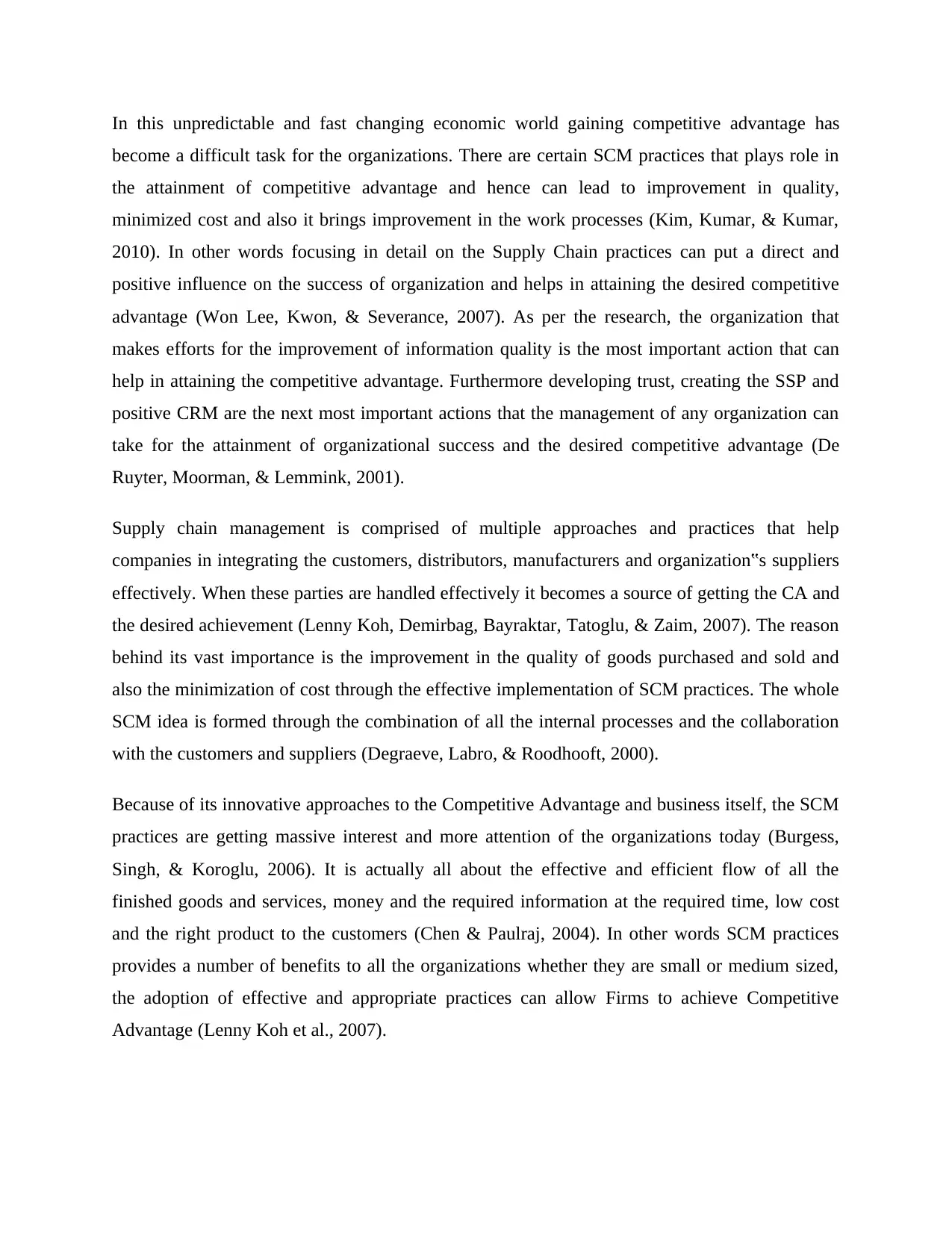
In this unpredictable and fast changing economic world gaining competitive advantage has
become a difficult task for the organizations. There are certain SCM practices that plays role in
the attainment of competitive advantage and hence can lead to improvement in quality,
minimized cost and also it brings improvement in the work processes (Kim, Kumar, & Kumar,
2010). In other words focusing in detail on the Supply Chain practices can put a direct and
positive influence on the success of organization and helps in attaining the desired competitive
advantage (Won Lee, Kwon, & Severance, 2007). As per the research, the organization that
makes efforts for the improvement of information quality is the most important action that can
help in attaining the competitive advantage. Furthermore developing trust, creating the SSP and
positive CRM are the next most important actions that the management of any organization can
take for the attainment of organizational success and the desired competitive advantage (De
Ruyter, Moorman, & Lemmink, 2001).
Supply chain management is comprised of multiple approaches and practices that help
companies in integrating the customers, distributors, manufacturers and organization‟s suppliers
effectively. When these parties are handled effectively it becomes a source of getting the CA and
the desired achievement (Lenny Koh, Demirbag, Bayraktar, Tatoglu, & Zaim, 2007). The reason
behind its vast importance is the improvement in the quality of goods purchased and sold and
also the minimization of cost through the effective implementation of SCM practices. The whole
SCM idea is formed through the combination of all the internal processes and the collaboration
with the customers and suppliers (Degraeve, Labro, & Roodhooft, 2000).
Because of its innovative approaches to the Competitive Advantage and business itself, the SCM
practices are getting massive interest and more attention of the organizations today (Burgess,
Singh, & Koroglu, 2006). It is actually all about the effective and efficient flow of all the
finished goods and services, money and the required information at the required time, low cost
and the right product to the customers (Chen & Paulraj, 2004). In other words SCM practices
provides a number of benefits to all the organizations whether they are small or medium sized,
the adoption of effective and appropriate practices can allow Firms to achieve Competitive
Advantage (Lenny Koh et al., 2007).
become a difficult task for the organizations. There are certain SCM practices that plays role in
the attainment of competitive advantage and hence can lead to improvement in quality,
minimized cost and also it brings improvement in the work processes (Kim, Kumar, & Kumar,
2010). In other words focusing in detail on the Supply Chain practices can put a direct and
positive influence on the success of organization and helps in attaining the desired competitive
advantage (Won Lee, Kwon, & Severance, 2007). As per the research, the organization that
makes efforts for the improvement of information quality is the most important action that can
help in attaining the competitive advantage. Furthermore developing trust, creating the SSP and
positive CRM are the next most important actions that the management of any organization can
take for the attainment of organizational success and the desired competitive advantage (De
Ruyter, Moorman, & Lemmink, 2001).
Supply chain management is comprised of multiple approaches and practices that help
companies in integrating the customers, distributors, manufacturers and organization‟s suppliers
effectively. When these parties are handled effectively it becomes a source of getting the CA and
the desired achievement (Lenny Koh, Demirbag, Bayraktar, Tatoglu, & Zaim, 2007). The reason
behind its vast importance is the improvement in the quality of goods purchased and sold and
also the minimization of cost through the effective implementation of SCM practices. The whole
SCM idea is formed through the combination of all the internal processes and the collaboration
with the customers and suppliers (Degraeve, Labro, & Roodhooft, 2000).
Because of its innovative approaches to the Competitive Advantage and business itself, the SCM
practices are getting massive interest and more attention of the organizations today (Burgess,
Singh, & Koroglu, 2006). It is actually all about the effective and efficient flow of all the
finished goods and services, money and the required information at the required time, low cost
and the right product to the customers (Chen & Paulraj, 2004). In other words SCM practices
provides a number of benefits to all the organizations whether they are small or medium sized,
the adoption of effective and appropriate practices can allow Firms to achieve Competitive
Advantage (Lenny Koh et al., 2007).
⊘ This is a preview!⊘
Do you want full access?
Subscribe today to unlock all pages.

Trusted by 1+ million students worldwide
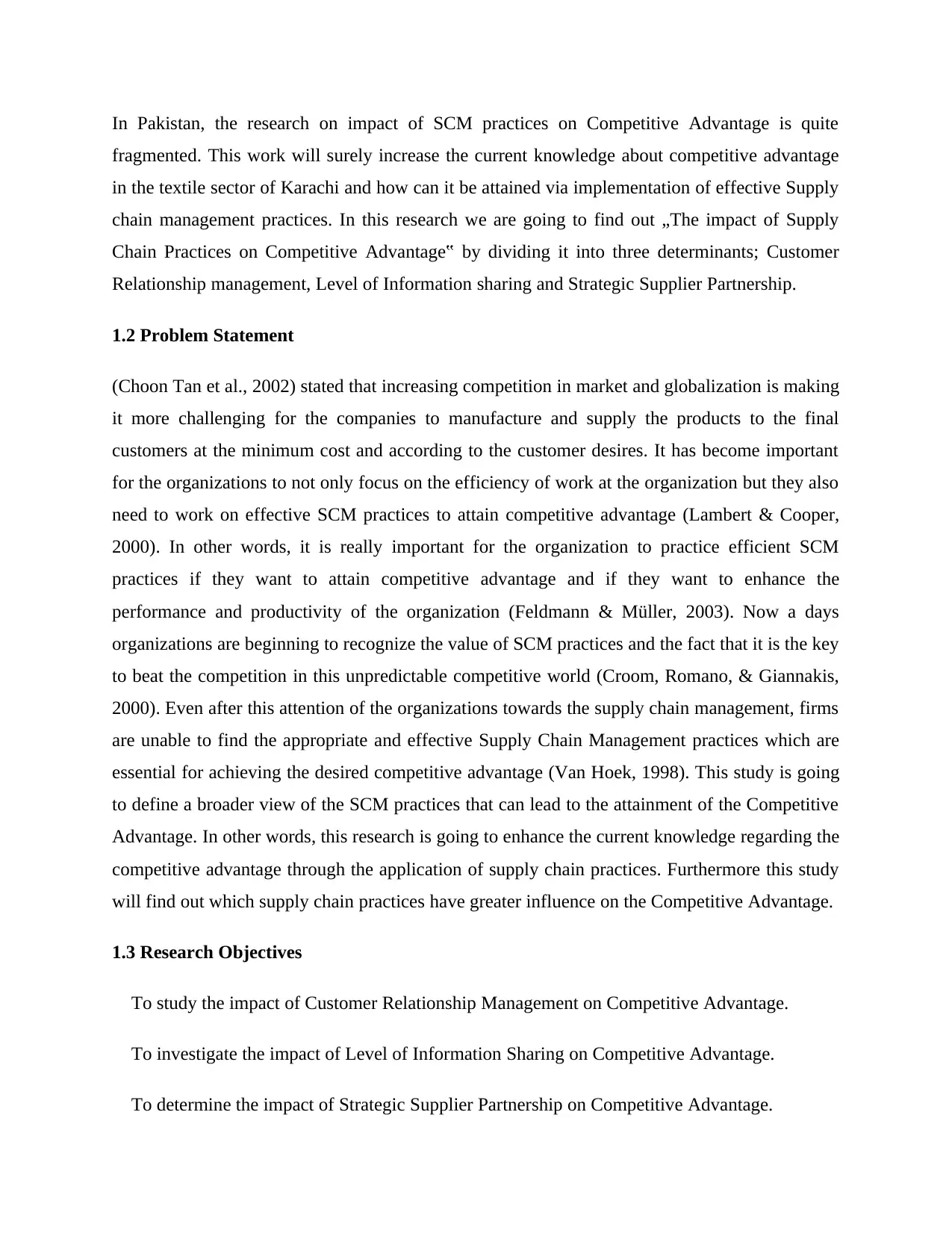
In Pakistan, the research on impact of SCM practices on Competitive Advantage is quite
fragmented. This work will surely increase the current knowledge about competitive advantage
in the textile sector of Karachi and how can it be attained via implementation of effective Supply
chain management practices. In this research we are going to find out „The impact of Supply
Chain Practices on Competitive Advantage‟ by dividing it into three determinants; Customer
Relationship management, Level of Information sharing and Strategic Supplier Partnership.
1.2 Problem Statement
(Choon Tan et al., 2002) stated that increasing competition in market and globalization is making
it more challenging for the companies to manufacture and supply the products to the final
customers at the minimum cost and according to the customer desires. It has become important
for the organizations to not only focus on the efficiency of work at the organization but they also
need to work on effective SCM practices to attain competitive advantage (Lambert & Cooper,
2000). In other words, it is really important for the organization to practice efficient SCM
practices if they want to attain competitive advantage and if they want to enhance the
performance and productivity of the organization (Feldmann & Müller, 2003). Now a days
organizations are beginning to recognize the value of SCM practices and the fact that it is the key
to beat the competition in this unpredictable competitive world (Croom, Romano, & Giannakis,
2000). Even after this attention of the organizations towards the supply chain management, firms
are unable to find the appropriate and effective Supply Chain Management practices which are
essential for achieving the desired competitive advantage (Van Hoek, 1998). This study is going
to define a broader view of the SCM practices that can lead to the attainment of the Competitive
Advantage. In other words, this research is going to enhance the current knowledge regarding the
competitive advantage through the application of supply chain practices. Furthermore this study
will find out which supply chain practices have greater influence on the Competitive Advantage.
1.3 Research Objectives
To study the impact of Customer Relationship Management on Competitive Advantage.
To investigate the impact of Level of Information Sharing on Competitive Advantage.
To determine the impact of Strategic Supplier Partnership on Competitive Advantage.
fragmented. This work will surely increase the current knowledge about competitive advantage
in the textile sector of Karachi and how can it be attained via implementation of effective Supply
chain management practices. In this research we are going to find out „The impact of Supply
Chain Practices on Competitive Advantage‟ by dividing it into three determinants; Customer
Relationship management, Level of Information sharing and Strategic Supplier Partnership.
1.2 Problem Statement
(Choon Tan et al., 2002) stated that increasing competition in market and globalization is making
it more challenging for the companies to manufacture and supply the products to the final
customers at the minimum cost and according to the customer desires. It has become important
for the organizations to not only focus on the efficiency of work at the organization but they also
need to work on effective SCM practices to attain competitive advantage (Lambert & Cooper,
2000). In other words, it is really important for the organization to practice efficient SCM
practices if they want to attain competitive advantage and if they want to enhance the
performance and productivity of the organization (Feldmann & Müller, 2003). Now a days
organizations are beginning to recognize the value of SCM practices and the fact that it is the key
to beat the competition in this unpredictable competitive world (Croom, Romano, & Giannakis,
2000). Even after this attention of the organizations towards the supply chain management, firms
are unable to find the appropriate and effective Supply Chain Management practices which are
essential for achieving the desired competitive advantage (Van Hoek, 1998). This study is going
to define a broader view of the SCM practices that can lead to the attainment of the Competitive
Advantage. In other words, this research is going to enhance the current knowledge regarding the
competitive advantage through the application of supply chain practices. Furthermore this study
will find out which supply chain practices have greater influence on the Competitive Advantage.
1.3 Research Objectives
To study the impact of Customer Relationship Management on Competitive Advantage.
To investigate the impact of Level of Information Sharing on Competitive Advantage.
To determine the impact of Strategic Supplier Partnership on Competitive Advantage.
Paraphrase This Document
Need a fresh take? Get an instant paraphrase of this document with our AI Paraphraser
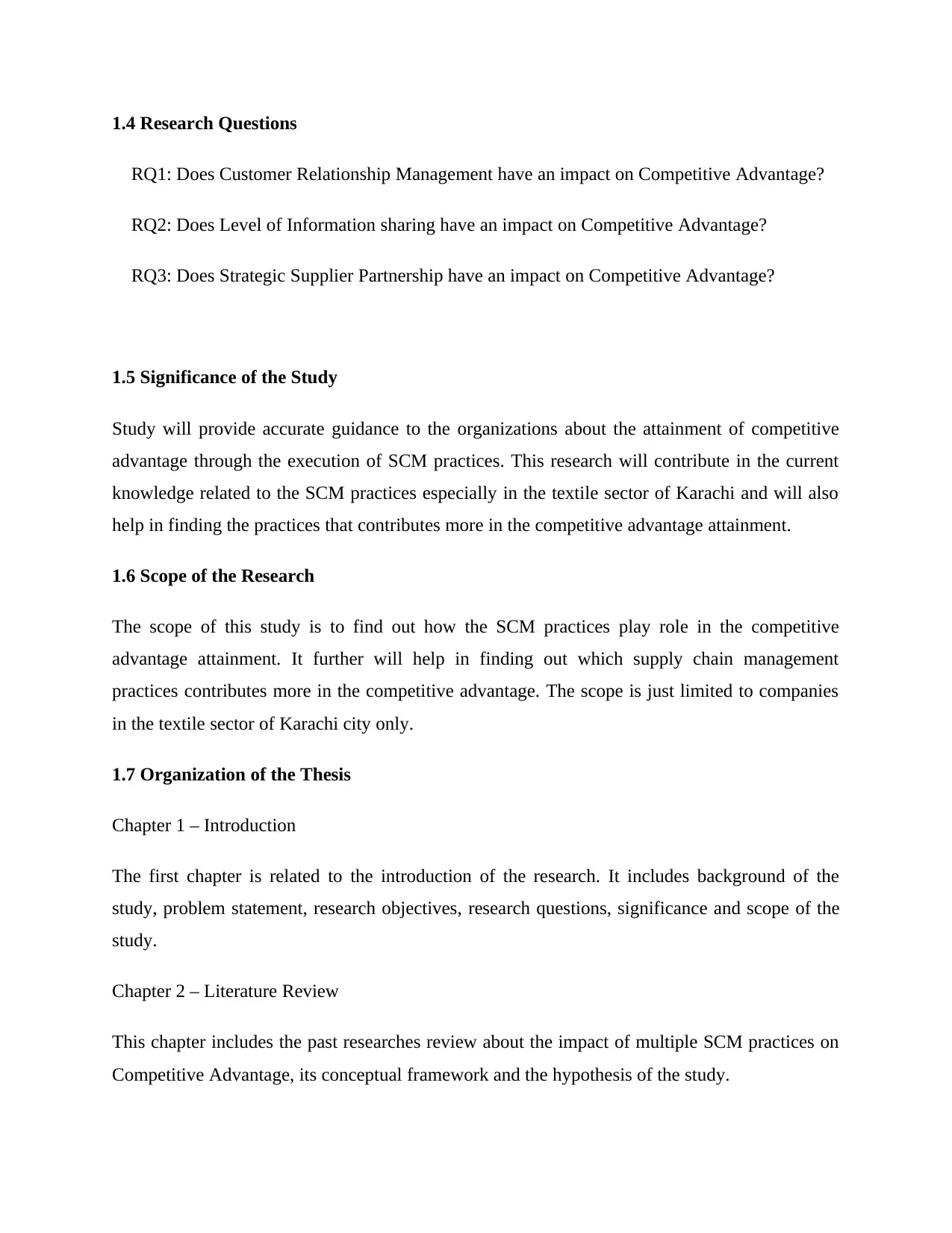
1.4 Research Questions
RQ1: Does Customer Relationship Management have an impact on Competitive Advantage?
RQ2: Does Level of Information sharing have an impact on Competitive Advantage?
RQ3: Does Strategic Supplier Partnership have an impact on Competitive Advantage?
1.5 Significance of the Study
Study will provide accurate guidance to the organizations about the attainment of competitive
advantage through the execution of SCM practices. This research will contribute in the current
knowledge related to the SCM practices especially in the textile sector of Karachi and will also
help in finding the practices that contributes more in the competitive advantage attainment.
1.6 Scope of the Research
The scope of this study is to find out how the SCM practices play role in the competitive
advantage attainment. It further will help in finding out which supply chain management
practices contributes more in the competitive advantage. The scope is just limited to companies
in the textile sector of Karachi city only.
1.7 Organization of the Thesis
Chapter 1 – Introduction
The first chapter is related to the introduction of the research. It includes background of the
study, problem statement, research objectives, research questions, significance and scope of the
study.
Chapter 2 – Literature Review
This chapter includes the past researches review about the impact of multiple SCM practices on
Competitive Advantage, its conceptual framework and the hypothesis of the study.
RQ1: Does Customer Relationship Management have an impact on Competitive Advantage?
RQ2: Does Level of Information sharing have an impact on Competitive Advantage?
RQ3: Does Strategic Supplier Partnership have an impact on Competitive Advantage?
1.5 Significance of the Study
Study will provide accurate guidance to the organizations about the attainment of competitive
advantage through the execution of SCM practices. This research will contribute in the current
knowledge related to the SCM practices especially in the textile sector of Karachi and will also
help in finding the practices that contributes more in the competitive advantage attainment.
1.6 Scope of the Research
The scope of this study is to find out how the SCM practices play role in the competitive
advantage attainment. It further will help in finding out which supply chain management
practices contributes more in the competitive advantage. The scope is just limited to companies
in the textile sector of Karachi city only.
1.7 Organization of the Thesis
Chapter 1 – Introduction
The first chapter is related to the introduction of the research. It includes background of the
study, problem statement, research objectives, research questions, significance and scope of the
study.
Chapter 2 – Literature Review
This chapter includes the past researches review about the impact of multiple SCM practices on
Competitive Advantage, its conceptual framework and the hypothesis of the study.
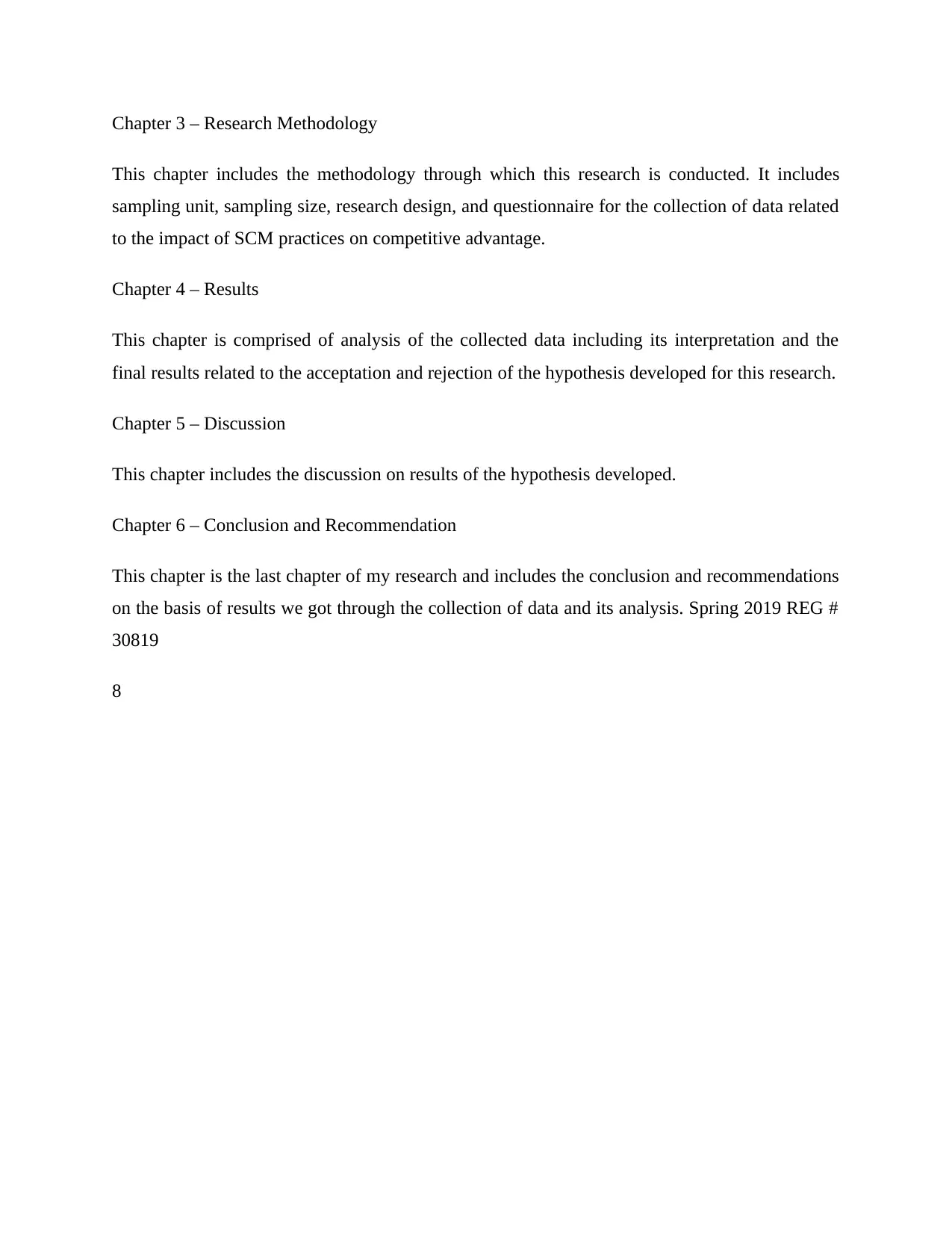
Chapter 3 – Research Methodology
This chapter includes the methodology through which this research is conducted. It includes
sampling unit, sampling size, research design, and questionnaire for the collection of data related
to the impact of SCM practices on competitive advantage.
Chapter 4 – Results
This chapter is comprised of analysis of the collected data including its interpretation and the
final results related to the acceptation and rejection of the hypothesis developed for this research.
Chapter 5 – Discussion
This chapter includes the discussion on results of the hypothesis developed.
Chapter 6 – Conclusion and Recommendation
This chapter is the last chapter of my research and includes the conclusion and recommendations
on the basis of results we got through the collection of data and its analysis. Spring 2019 REG #
30819
8
This chapter includes the methodology through which this research is conducted. It includes
sampling unit, sampling size, research design, and questionnaire for the collection of data related
to the impact of SCM practices on competitive advantage.
Chapter 4 – Results
This chapter is comprised of analysis of the collected data including its interpretation and the
final results related to the acceptation and rejection of the hypothesis developed for this research.
Chapter 5 – Discussion
This chapter includes the discussion on results of the hypothesis developed.
Chapter 6 – Conclusion and Recommendation
This chapter is the last chapter of my research and includes the conclusion and recommendations
on the basis of results we got through the collection of data and its analysis. Spring 2019 REG #
30819
8
⊘ This is a preview!⊘
Do you want full access?
Subscribe today to unlock all pages.

Trusted by 1+ million students worldwide
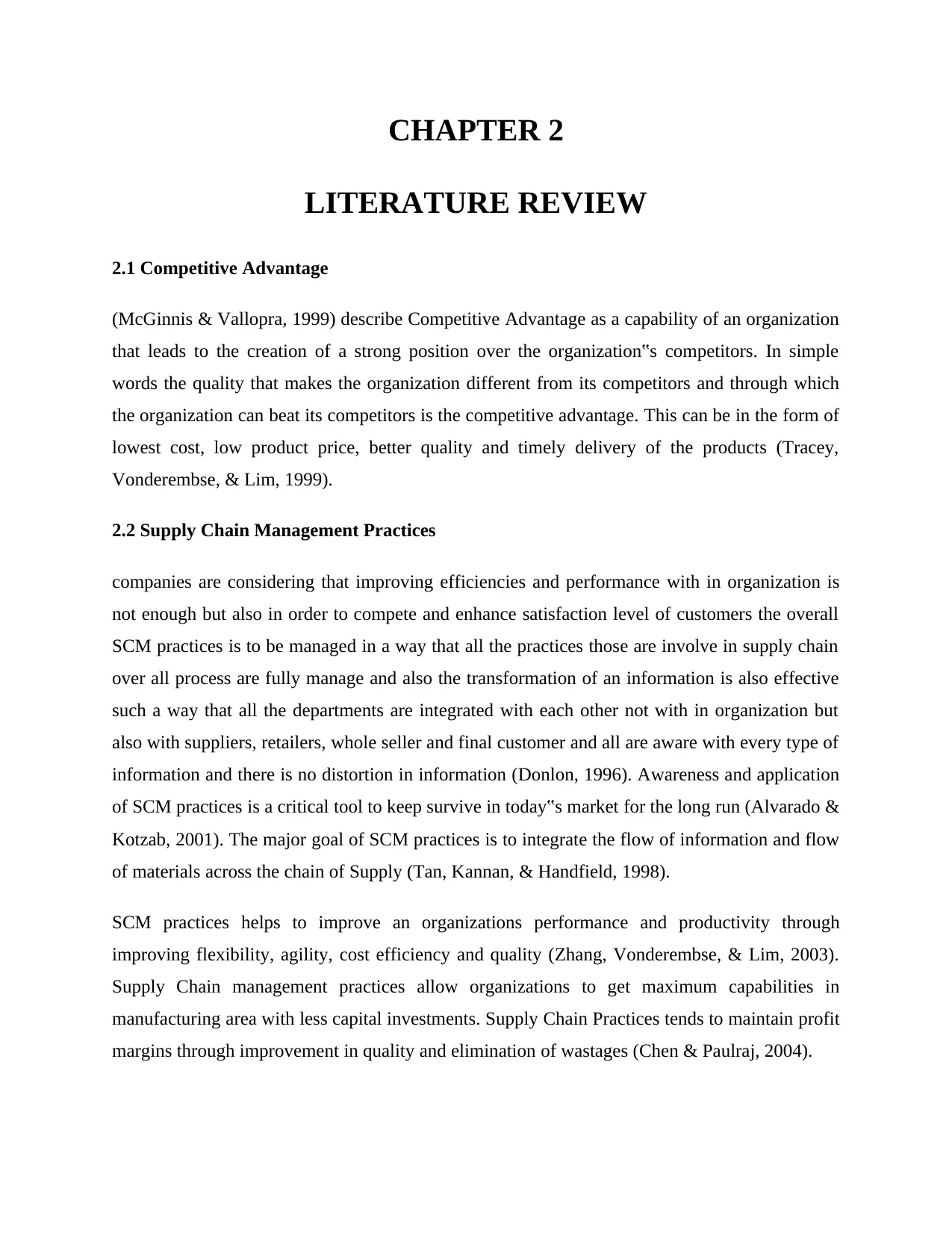
CHAPTER 2
LITERATURE REVIEW
2.1 Competitive Advantage
(McGinnis & Vallopra, 1999) describe Competitive Advantage as a capability of an organization
that leads to the creation of a strong position over the organization‟s competitors. In simple
words the quality that makes the organization different from its competitors and through which
the organization can beat its competitors is the competitive advantage. This can be in the form of
lowest cost, low product price, better quality and timely delivery of the products (Tracey,
Vonderembse, & Lim, 1999).
2.2 Supply Chain Management Practices
companies are considering that improving efficiencies and performance with in organization is
not enough but also in order to compete and enhance satisfaction level of customers the overall
SCM practices is to be managed in a way that all the practices those are involve in supply chain
over all process are fully manage and also the transformation of an information is also effective
such a way that all the departments are integrated with each other not with in organization but
also with suppliers, retailers, whole seller and final customer and all are aware with every type of
information and there is no distortion in information (Donlon, 1996). Awareness and application
of SCM practices is a critical tool to keep survive in today‟s market for the long run (Alvarado &
Kotzab, 2001). The major goal of SCM practices is to integrate the flow of information and flow
of materials across the chain of Supply (Tan, Kannan, & Handfield, 1998).
SCM practices helps to improve an organizations performance and productivity through
improving flexibility, agility, cost efficiency and quality (Zhang, Vonderembse, & Lim, 2003).
Supply Chain management practices allow organizations to get maximum capabilities in
manufacturing area with less capital investments. Supply Chain Practices tends to maintain profit
margins through improvement in quality and elimination of wastages (Chen & Paulraj, 2004).
LITERATURE REVIEW
2.1 Competitive Advantage
(McGinnis & Vallopra, 1999) describe Competitive Advantage as a capability of an organization
that leads to the creation of a strong position over the organization‟s competitors. In simple
words the quality that makes the organization different from its competitors and through which
the organization can beat its competitors is the competitive advantage. This can be in the form of
lowest cost, low product price, better quality and timely delivery of the products (Tracey,
Vonderembse, & Lim, 1999).
2.2 Supply Chain Management Practices
companies are considering that improving efficiencies and performance with in organization is
not enough but also in order to compete and enhance satisfaction level of customers the overall
SCM practices is to be managed in a way that all the practices those are involve in supply chain
over all process are fully manage and also the transformation of an information is also effective
such a way that all the departments are integrated with each other not with in organization but
also with suppliers, retailers, whole seller and final customer and all are aware with every type of
information and there is no distortion in information (Donlon, 1996). Awareness and application
of SCM practices is a critical tool to keep survive in today‟s market for the long run (Alvarado &
Kotzab, 2001). The major goal of SCM practices is to integrate the flow of information and flow
of materials across the chain of Supply (Tan, Kannan, & Handfield, 1998).
SCM practices helps to improve an organizations performance and productivity through
improving flexibility, agility, cost efficiency and quality (Zhang, Vonderembse, & Lim, 2003).
Supply Chain management practices allow organizations to get maximum capabilities in
manufacturing area with less capital investments. Supply Chain Practices tends to maintain profit
margins through improvement in quality and elimination of wastages (Chen & Paulraj, 2004).
Paraphrase This Document
Need a fresh take? Get an instant paraphrase of this document with our AI Paraphraser
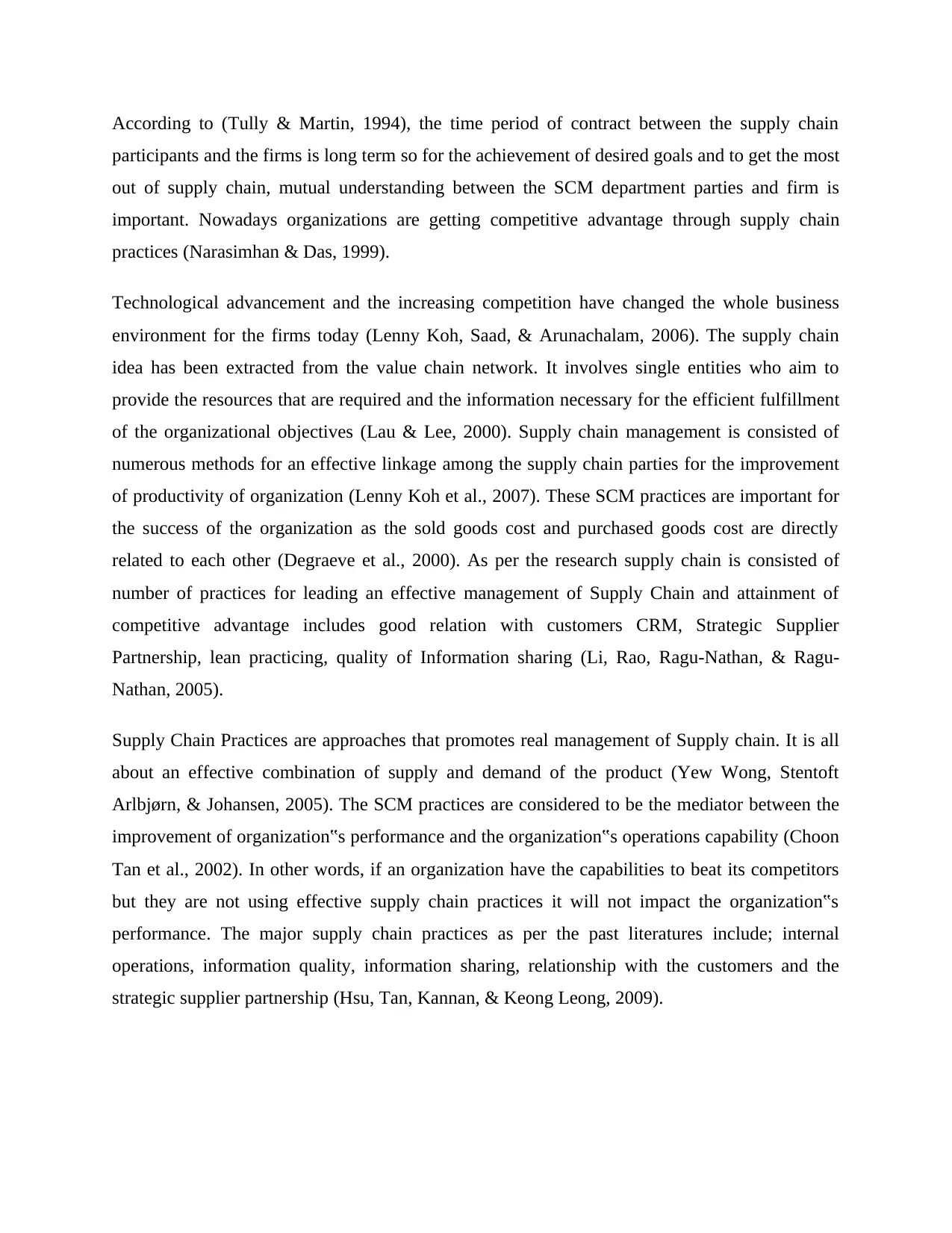
According to (Tully & Martin, 1994), the time period of contract between the supply chain
participants and the firms is long term so for the achievement of desired goals and to get the most
out of supply chain, mutual understanding between the SCM department parties and firm is
important. Nowadays organizations are getting competitive advantage through supply chain
practices (Narasimhan & Das, 1999).
Technological advancement and the increasing competition have changed the whole business
environment for the firms today (Lenny Koh, Saad, & Arunachalam, 2006). The supply chain
idea has been extracted from the value chain network. It involves single entities who aim to
provide the resources that are required and the information necessary for the efficient fulfillment
of the organizational objectives (Lau & Lee, 2000). Supply chain management is consisted of
numerous methods for an effective linkage among the supply chain parties for the improvement
of productivity of organization (Lenny Koh et al., 2007). These SCM practices are important for
the success of the organization as the sold goods cost and purchased goods cost are directly
related to each other (Degraeve et al., 2000). As per the research supply chain is consisted of
number of practices for leading an effective management of Supply Chain and attainment of
competitive advantage includes good relation with customers CRM, Strategic Supplier
Partnership, lean practicing, quality of Information sharing (Li, Rao, Ragu-Nathan, & Ragu-
Nathan, 2005).
Supply Chain Practices are approaches that promotes real management of Supply chain. It is all
about an effective combination of supply and demand of the product (Yew Wong, Stentoft
Arlbjørn, & Johansen, 2005). The SCM practices are considered to be the mediator between the
improvement of organization‟s performance and the organization‟s operations capability (Choon
Tan et al., 2002). In other words, if an organization have the capabilities to beat its competitors
but they are not using effective supply chain practices it will not impact the organization‟s
performance. The major supply chain practices as per the past literatures include; internal
operations, information quality, information sharing, relationship with the customers and the
strategic supplier partnership (Hsu, Tan, Kannan, & Keong Leong, 2009).
participants and the firms is long term so for the achievement of desired goals and to get the most
out of supply chain, mutual understanding between the SCM department parties and firm is
important. Nowadays organizations are getting competitive advantage through supply chain
practices (Narasimhan & Das, 1999).
Technological advancement and the increasing competition have changed the whole business
environment for the firms today (Lenny Koh, Saad, & Arunachalam, 2006). The supply chain
idea has been extracted from the value chain network. It involves single entities who aim to
provide the resources that are required and the information necessary for the efficient fulfillment
of the organizational objectives (Lau & Lee, 2000). Supply chain management is consisted of
numerous methods for an effective linkage among the supply chain parties for the improvement
of productivity of organization (Lenny Koh et al., 2007). These SCM practices are important for
the success of the organization as the sold goods cost and purchased goods cost are directly
related to each other (Degraeve et al., 2000). As per the research supply chain is consisted of
number of practices for leading an effective management of Supply Chain and attainment of
competitive advantage includes good relation with customers CRM, Strategic Supplier
Partnership, lean practicing, quality of Information sharing (Li, Rao, Ragu-Nathan, & Ragu-
Nathan, 2005).
Supply Chain Practices are approaches that promotes real management of Supply chain. It is all
about an effective combination of supply and demand of the product (Yew Wong, Stentoft
Arlbjørn, & Johansen, 2005). The SCM practices are considered to be the mediator between the
improvement of organization‟s performance and the organization‟s operations capability (Choon
Tan et al., 2002). In other words, if an organization have the capabilities to beat its competitors
but they are not using effective supply chain practices it will not impact the organization‟s
performance. The major supply chain practices as per the past literatures include; internal
operations, information quality, information sharing, relationship with the customers and the
strategic supplier partnership (Hsu, Tan, Kannan, & Keong Leong, 2009).
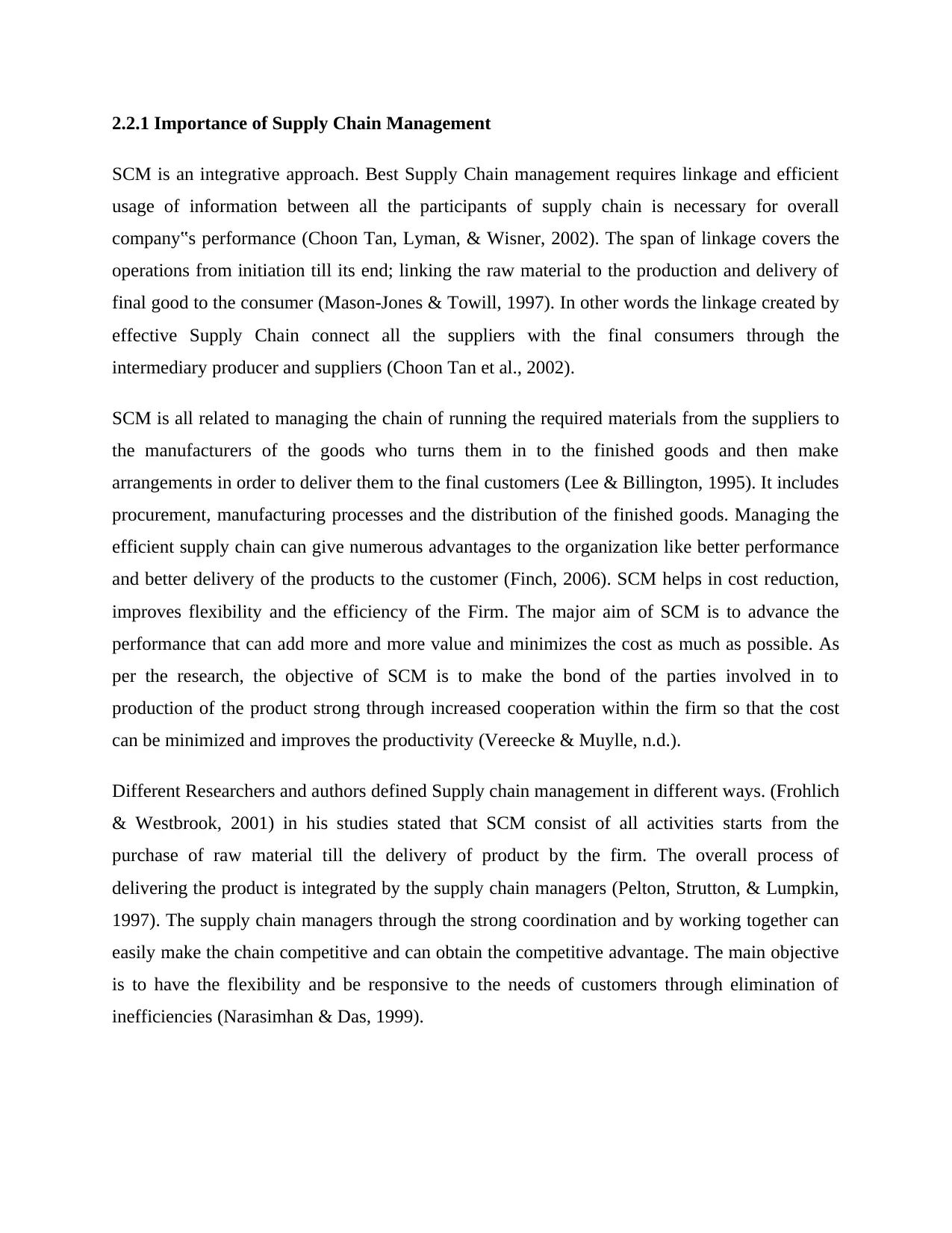
2.2.1 Importance of Supply Chain Management
SCM is an integrative approach. Best Supply Chain management requires linkage and efficient
usage of information between all the participants of supply chain is necessary for overall
company‟s performance (Choon Tan, Lyman, & Wisner, 2002). The span of linkage covers the
operations from initiation till its end; linking the raw material to the production and delivery of
final good to the consumer (Mason‐Jones & Towill, 1997). In other words the linkage created by
effective Supply Chain connect all the suppliers with the final consumers through the
intermediary producer and suppliers (Choon Tan et al., 2002).
SCM is all related to managing the chain of running the required materials from the suppliers to
the manufacturers of the goods who turns them in to the finished goods and then make
arrangements in order to deliver them to the final customers (Lee & Billington, 1995). It includes
procurement, manufacturing processes and the distribution of the finished goods. Managing the
efficient supply chain can give numerous advantages to the organization like better performance
and better delivery of the products to the customer (Finch, 2006). SCM helps in cost reduction,
improves flexibility and the efficiency of the Firm. The major aim of SCM is to advance the
performance that can add more and more value and minimizes the cost as much as possible. As
per the research, the objective of SCM is to make the bond of the parties involved in to
production of the product strong through increased cooperation within the firm so that the cost
can be minimized and improves the productivity (Vereecke & Muylle, n.d.).
Different Researchers and authors defined Supply chain management in different ways. (Frohlich
& Westbrook, 2001) in his studies stated that SCM consist of all activities starts from the
purchase of raw material till the delivery of product by the firm. The overall process of
delivering the product is integrated by the supply chain managers (Pelton, Strutton, & Lumpkin,
1997). The supply chain managers through the strong coordination and by working together can
easily make the chain competitive and can obtain the competitive advantage. The main objective
is to have the flexibility and be responsive to the needs of customers through elimination of
inefficiencies (Narasimhan & Das, 1999).
SCM is an integrative approach. Best Supply Chain management requires linkage and efficient
usage of information between all the participants of supply chain is necessary for overall
company‟s performance (Choon Tan, Lyman, & Wisner, 2002). The span of linkage covers the
operations from initiation till its end; linking the raw material to the production and delivery of
final good to the consumer (Mason‐Jones & Towill, 1997). In other words the linkage created by
effective Supply Chain connect all the suppliers with the final consumers through the
intermediary producer and suppliers (Choon Tan et al., 2002).
SCM is all related to managing the chain of running the required materials from the suppliers to
the manufacturers of the goods who turns them in to the finished goods and then make
arrangements in order to deliver them to the final customers (Lee & Billington, 1995). It includes
procurement, manufacturing processes and the distribution of the finished goods. Managing the
efficient supply chain can give numerous advantages to the organization like better performance
and better delivery of the products to the customer (Finch, 2006). SCM helps in cost reduction,
improves flexibility and the efficiency of the Firm. The major aim of SCM is to advance the
performance that can add more and more value and minimizes the cost as much as possible. As
per the research, the objective of SCM is to make the bond of the parties involved in to
production of the product strong through increased cooperation within the firm so that the cost
can be minimized and improves the productivity (Vereecke & Muylle, n.d.).
Different Researchers and authors defined Supply chain management in different ways. (Frohlich
& Westbrook, 2001) in his studies stated that SCM consist of all activities starts from the
purchase of raw material till the delivery of product by the firm. The overall process of
delivering the product is integrated by the supply chain managers (Pelton, Strutton, & Lumpkin,
1997). The supply chain managers through the strong coordination and by working together can
easily make the chain competitive and can obtain the competitive advantage. The main objective
is to have the flexibility and be responsive to the needs of customers through elimination of
inefficiencies (Narasimhan & Das, 1999).
⊘ This is a preview!⊘
Do you want full access?
Subscribe today to unlock all pages.

Trusted by 1+ million students worldwide
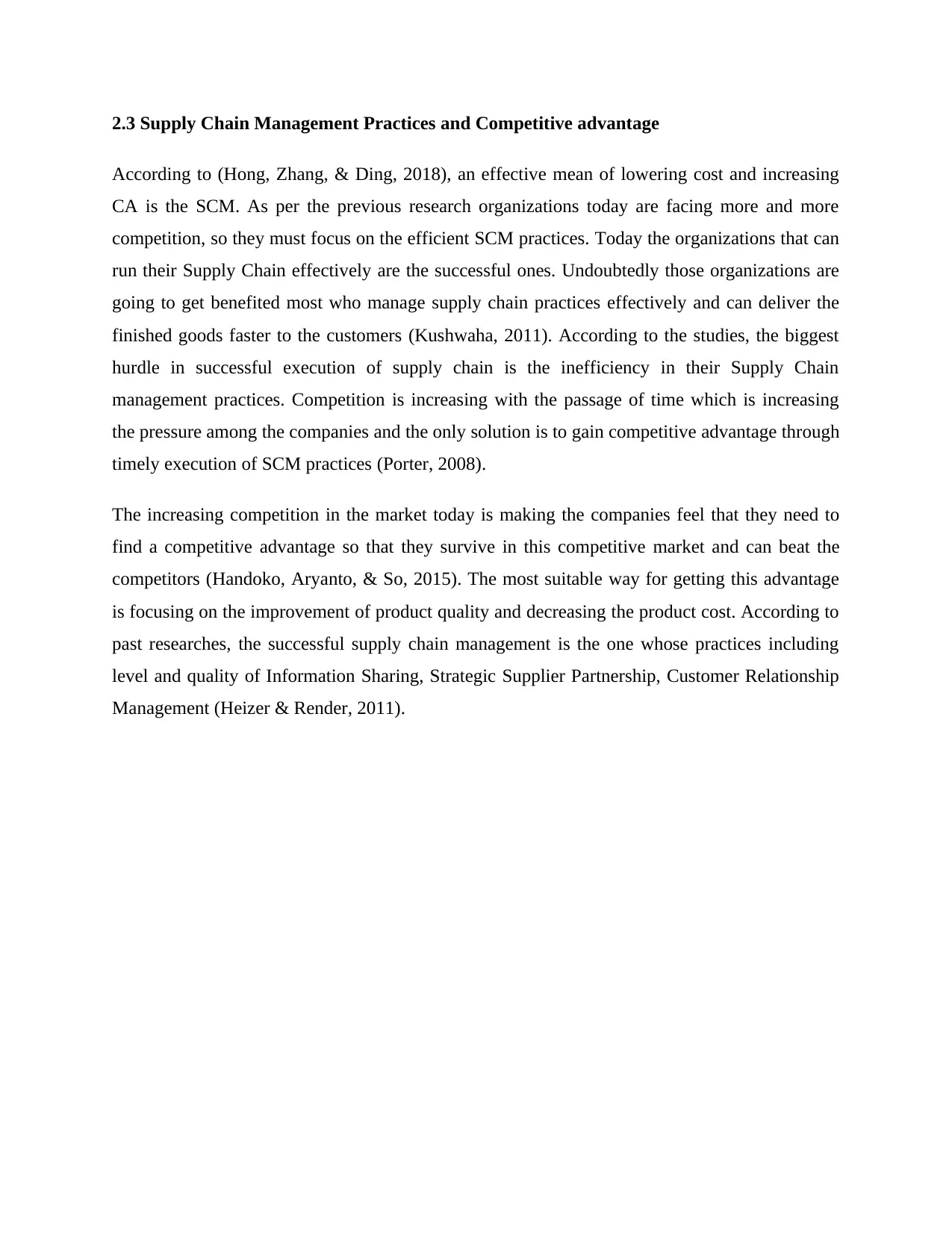
2.3 Supply Chain Management Practices and Competitive advantage
According to (Hong, Zhang, & Ding, 2018), an effective mean of lowering cost and increasing
CA is the SCM. As per the previous research organizations today are facing more and more
competition, so they must focus on the efficient SCM practices. Today the organizations that can
run their Supply Chain effectively are the successful ones. Undoubtedly those organizations are
going to get benefited most who manage supply chain practices effectively and can deliver the
finished goods faster to the customers (Kushwaha, 2011). According to the studies, the biggest
hurdle in successful execution of supply chain is the inefficiency in their Supply Chain
management practices. Competition is increasing with the passage of time which is increasing
the pressure among the companies and the only solution is to gain competitive advantage through
timely execution of SCM practices (Porter, 2008).
The increasing competition in the market today is making the companies feel that they need to
find a competitive advantage so that they survive in this competitive market and can beat the
competitors (Handoko, Aryanto, & So, 2015). The most suitable way for getting this advantage
is focusing on the improvement of product quality and decreasing the product cost. According to
past researches, the successful supply chain management is the one whose practices including
level and quality of Information Sharing, Strategic Supplier Partnership, Customer Relationship
Management (Heizer & Render, 2011).
According to (Hong, Zhang, & Ding, 2018), an effective mean of lowering cost and increasing
CA is the SCM. As per the previous research organizations today are facing more and more
competition, so they must focus on the efficient SCM practices. Today the organizations that can
run their Supply Chain effectively are the successful ones. Undoubtedly those organizations are
going to get benefited most who manage supply chain practices effectively and can deliver the
finished goods faster to the customers (Kushwaha, 2011). According to the studies, the biggest
hurdle in successful execution of supply chain is the inefficiency in their Supply Chain
management practices. Competition is increasing with the passage of time which is increasing
the pressure among the companies and the only solution is to gain competitive advantage through
timely execution of SCM practices (Porter, 2008).
The increasing competition in the market today is making the companies feel that they need to
find a competitive advantage so that they survive in this competitive market and can beat the
competitors (Handoko, Aryanto, & So, 2015). The most suitable way for getting this advantage
is focusing on the improvement of product quality and decreasing the product cost. According to
past researches, the successful supply chain management is the one whose practices including
level and quality of Information Sharing, Strategic Supplier Partnership, Customer Relationship
Management (Heizer & Render, 2011).
Paraphrase This Document
Need a fresh take? Get an instant paraphrase of this document with our AI Paraphraser
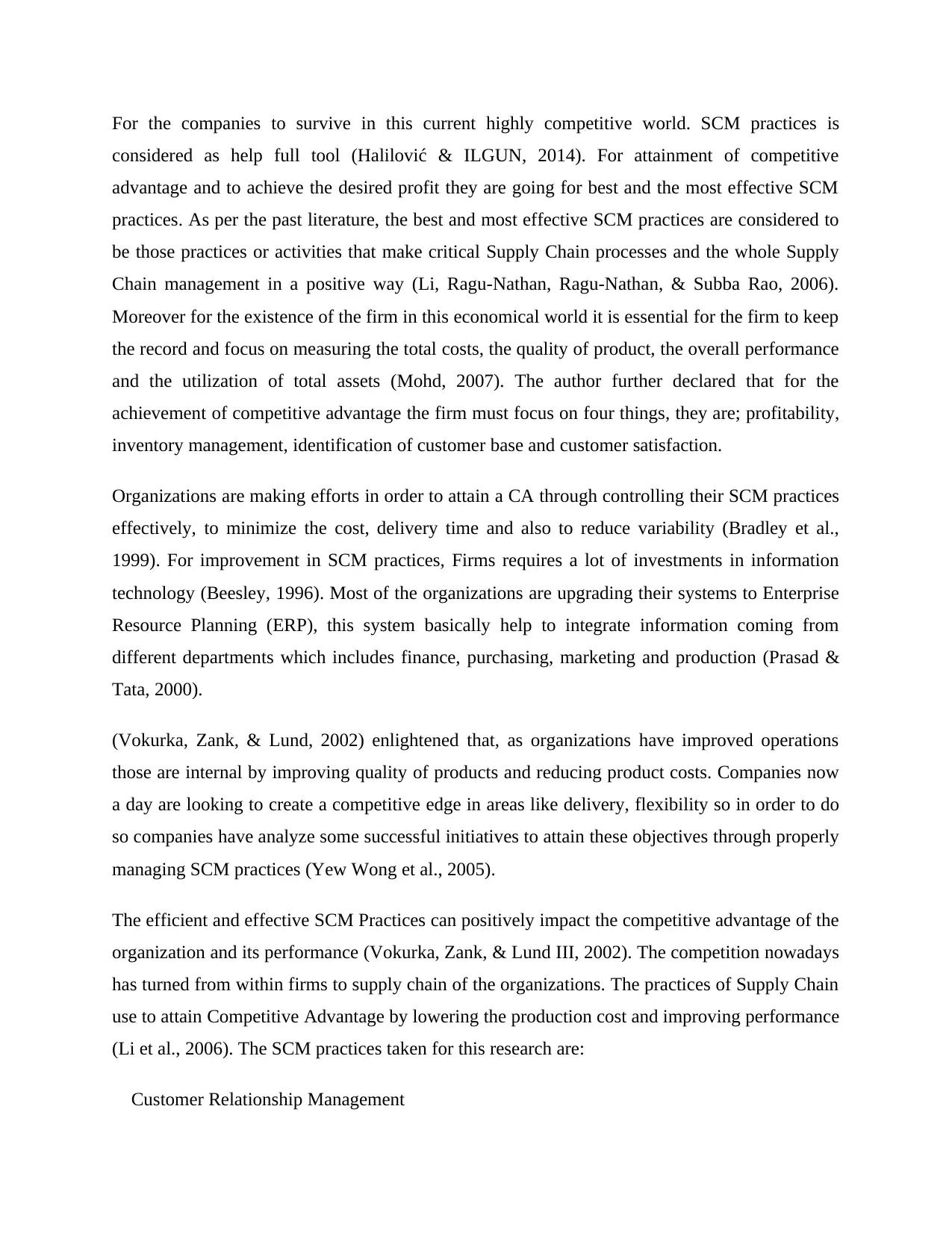
For the companies to survive in this current highly competitive world. SCM practices is
considered as help full tool (Halilović & ILGUN, 2014). For attainment of competitive
advantage and to achieve the desired profit they are going for best and the most effective SCM
practices. As per the past literature, the best and most effective SCM practices are considered to
be those practices or activities that make critical Supply Chain processes and the whole Supply
Chain management in a positive way (Li, Ragu-Nathan, Ragu-Nathan, & Subba Rao, 2006).
Moreover for the existence of the firm in this economical world it is essential for the firm to keep
the record and focus on measuring the total costs, the quality of product, the overall performance
and the utilization of total assets (Mohd, 2007). The author further declared that for the
achievement of competitive advantage the firm must focus on four things, they are; profitability,
inventory management, identification of customer base and customer satisfaction.
Organizations are making efforts in order to attain a CA through controlling their SCM practices
effectively, to minimize the cost, delivery time and also to reduce variability (Bradley et al.,
1999). For improvement in SCM practices, Firms requires a lot of investments in information
technology (Beesley, 1996). Most of the organizations are upgrading their systems to Enterprise
Resource Planning (ERP), this system basically help to integrate information coming from
different departments which includes finance, purchasing, marketing and production (Prasad &
Tata, 2000).
(Vokurka, Zank, & Lund, 2002) enlightened that, as organizations have improved operations
those are internal by improving quality of products and reducing product costs. Companies now
a day are looking to create a competitive edge in areas like delivery, flexibility so in order to do
so companies have analyze some successful initiatives to attain these objectives through properly
managing SCM practices (Yew Wong et al., 2005).
The efficient and effective SCM Practices can positively impact the competitive advantage of the
organization and its performance (Vokurka, Zank, & Lund III, 2002). The competition nowadays
has turned from within firms to supply chain of the organizations. The practices of Supply Chain
use to attain Competitive Advantage by lowering the production cost and improving performance
(Li et al., 2006). The SCM practices taken for this research are:
Customer Relationship Management
considered as help full tool (Halilović & ILGUN, 2014). For attainment of competitive
advantage and to achieve the desired profit they are going for best and the most effective SCM
practices. As per the past literature, the best and most effective SCM practices are considered to
be those practices or activities that make critical Supply Chain processes and the whole Supply
Chain management in a positive way (Li, Ragu-Nathan, Ragu-Nathan, & Subba Rao, 2006).
Moreover for the existence of the firm in this economical world it is essential for the firm to keep
the record and focus on measuring the total costs, the quality of product, the overall performance
and the utilization of total assets (Mohd, 2007). The author further declared that for the
achievement of competitive advantage the firm must focus on four things, they are; profitability,
inventory management, identification of customer base and customer satisfaction.
Organizations are making efforts in order to attain a CA through controlling their SCM practices
effectively, to minimize the cost, delivery time and also to reduce variability (Bradley et al.,
1999). For improvement in SCM practices, Firms requires a lot of investments in information
technology (Beesley, 1996). Most of the organizations are upgrading their systems to Enterprise
Resource Planning (ERP), this system basically help to integrate information coming from
different departments which includes finance, purchasing, marketing and production (Prasad &
Tata, 2000).
(Vokurka, Zank, & Lund, 2002) enlightened that, as organizations have improved operations
those are internal by improving quality of products and reducing product costs. Companies now
a day are looking to create a competitive edge in areas like delivery, flexibility so in order to do
so companies have analyze some successful initiatives to attain these objectives through properly
managing SCM practices (Yew Wong et al., 2005).
The efficient and effective SCM Practices can positively impact the competitive advantage of the
organization and its performance (Vokurka, Zank, & Lund III, 2002). The competition nowadays
has turned from within firms to supply chain of the organizations. The practices of Supply Chain
use to attain Competitive Advantage by lowering the production cost and improving performance
(Li et al., 2006). The SCM practices taken for this research are:
Customer Relationship Management
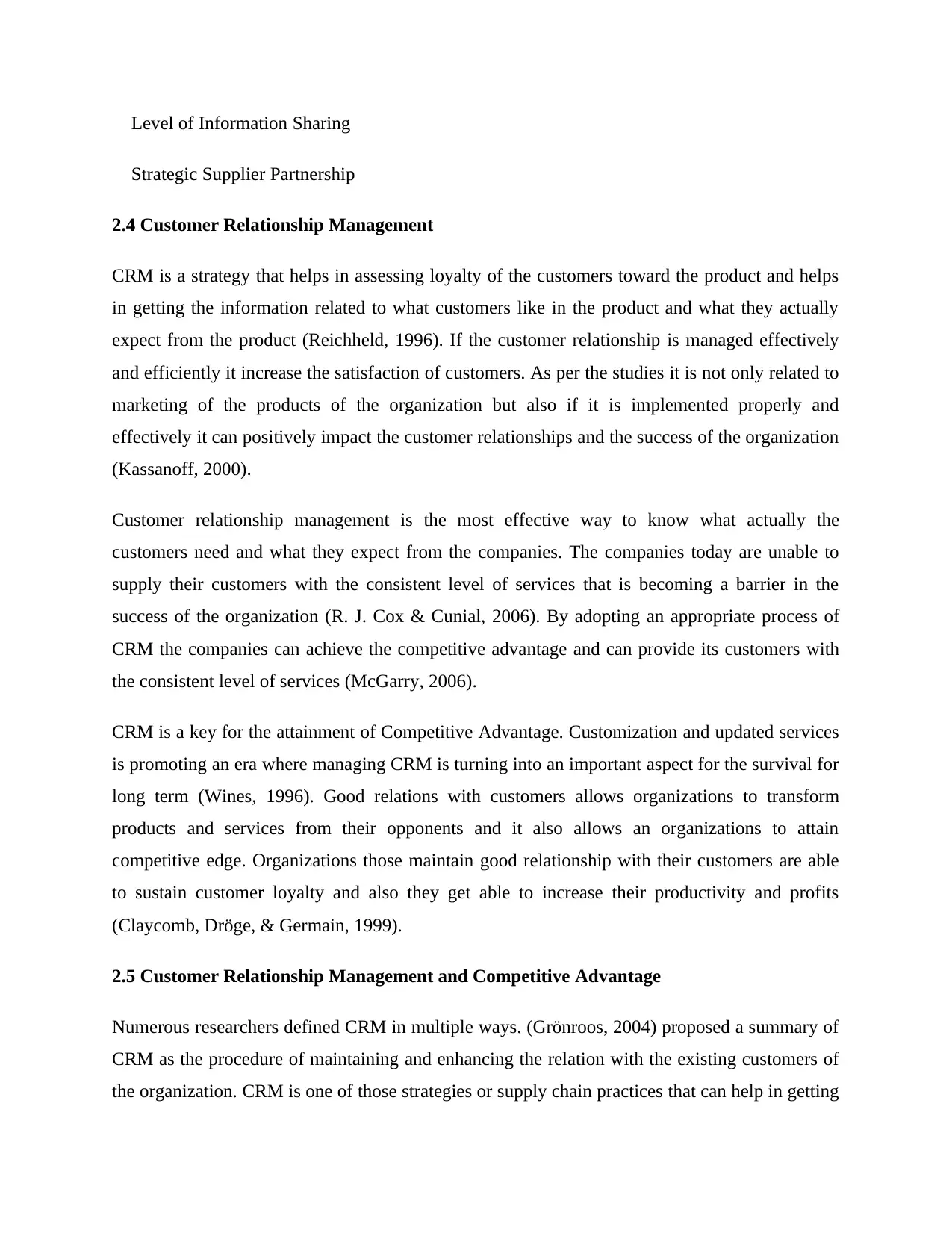
Level of Information Sharing
Strategic Supplier Partnership
2.4 Customer Relationship Management
CRM is a strategy that helps in assessing loyalty of the customers toward the product and helps
in getting the information related to what customers like in the product and what they actually
expect from the product (Reichheld, 1996). If the customer relationship is managed effectively
and efficiently it increase the satisfaction of customers. As per the studies it is not only related to
marketing of the products of the organization but also if it is implemented properly and
effectively it can positively impact the customer relationships and the success of the organization
(Kassanoff, 2000).
Customer relationship management is the most effective way to know what actually the
customers need and what they expect from the companies. The companies today are unable to
supply their customers with the consistent level of services that is becoming a barrier in the
success of the organization (R. J. Cox & Cunial, 2006). By adopting an appropriate process of
CRM the companies can achieve the competitive advantage and can provide its customers with
the consistent level of services (McGarry, 2006).
CRM is a key for the attainment of Competitive Advantage. Customization and updated services
is promoting an era where managing CRM is turning into an important aspect for the survival for
long term (Wines, 1996). Good relations with customers allows organizations to transform
products and services from their opponents and it also allows an organizations to attain
competitive edge. Organizations those maintain good relationship with their customers are able
to sustain customer loyalty and also they get able to increase their productivity and profits
(Claycomb, Dröge, & Germain, 1999).
2.5 Customer Relationship Management and Competitive Advantage
Numerous researchers defined CRM in multiple ways. (Grönroos, 2004) proposed a summary of
CRM as the procedure of maintaining and enhancing the relation with the existing customers of
the organization. CRM is one of those strategies or supply chain practices that can help in getting
Strategic Supplier Partnership
2.4 Customer Relationship Management
CRM is a strategy that helps in assessing loyalty of the customers toward the product and helps
in getting the information related to what customers like in the product and what they actually
expect from the product (Reichheld, 1996). If the customer relationship is managed effectively
and efficiently it increase the satisfaction of customers. As per the studies it is not only related to
marketing of the products of the organization but also if it is implemented properly and
effectively it can positively impact the customer relationships and the success of the organization
(Kassanoff, 2000).
Customer relationship management is the most effective way to know what actually the
customers need and what they expect from the companies. The companies today are unable to
supply their customers with the consistent level of services that is becoming a barrier in the
success of the organization (R. J. Cox & Cunial, 2006). By adopting an appropriate process of
CRM the companies can achieve the competitive advantage and can provide its customers with
the consistent level of services (McGarry, 2006).
CRM is a key for the attainment of Competitive Advantage. Customization and updated services
is promoting an era where managing CRM is turning into an important aspect for the survival for
long term (Wines, 1996). Good relations with customers allows organizations to transform
products and services from their opponents and it also allows an organizations to attain
competitive edge. Organizations those maintain good relationship with their customers are able
to sustain customer loyalty and also they get able to increase their productivity and profits
(Claycomb, Dröge, & Germain, 1999).
2.5 Customer Relationship Management and Competitive Advantage
Numerous researchers defined CRM in multiple ways. (Grönroos, 2004) proposed a summary of
CRM as the procedure of maintaining and enhancing the relation with the existing customers of
the organization. CRM is one of those strategies or supply chain practices that can help in getting
⊘ This is a preview!⊘
Do you want full access?
Subscribe today to unlock all pages.

Trusted by 1+ million students worldwide
1 out of 23
Related Documents
Your All-in-One AI-Powered Toolkit for Academic Success.
+13062052269
info@desklib.com
Available 24*7 on WhatsApp / Email
![[object Object]](/_next/static/media/star-bottom.7253800d.svg)
Unlock your academic potential
Copyright © 2020–2025 A2Z Services. All Rights Reserved. Developed and managed by ZUCOL.





